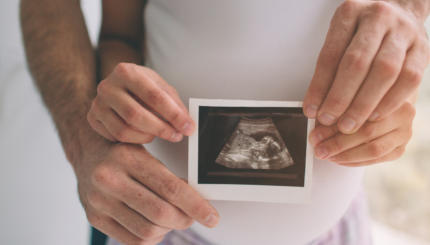The profoundly spiritual, emotional, and physical transitions involved in bringing a new child into the world have been marked by Jewish women since the days when they brought animal sacrifices to the Temple in Jerusalem–40 days after the birth of a boy, and 80 after the birth of a girl.
Continuously since biblical times, we have ritually circumcised our boys with brit milah, a ritual which expresses our most visceral and spiritual feelings. Many Jewish communities have also had ways of welcoming their daughters with celebrations that date as far back as the Middle Ages, but they were more often folk custom than religious ritual per se, and rarely had the same sense of spiritual weight or importance as brit milah. And with the dispersion and destruction of most of the Diaspora communities where these were practiced, most of these welcoming traditions died out.
In America until recent decades, common practice was for fathers (in the Orthodox world) or for both parents (in the liberal Jewish community) to go to synagogue for a brief ceremony in which their new daughter is formally named, and have a blessing recited hoping that she will grow up in good health to know Torah, marry under a wedding canopy, and do good deeds.
 With the dual impact of feminism and the democratic, do-it-yourself ethic that began to transform Judaism in the early 1970s (as it did much of American life), knowledgeable Jews began wondering how they could welcome their daughters in a way that seemed as serious and rich with meaning as the way in which they welcomed their sons.
With the dual impact of feminism and the democratic, do-it-yourself ethic that began to transform Judaism in the early 1970s (as it did much of American life), knowledgeable Jews began wondering how they could welcome their daughters in a way that seemed as serious and rich with meaning as the way in which they welcomed their sons.
With your help, My Jewish Learning can provide endless opportunities for learning, connection and discovery.
Michael and Sharon Strassfeld, central players in what is now known as the havurah movement, created the first welcoming ceremony for their daughter, Kayla, in 1973. The Strassfelds also edited the ground-breaking Jewish Catalog series of books, which put do-it-yourself Judaism literally into people’s hands.
It was about that time that two Reform rabbis published a new ritual, called kiddush peter rechem (sanctification of the womb’s opening), to mark the arrival of a first child of either sex, an egalitarian parallel to the traditional pidyon ha-ben, or ceremonial redemption of a one-month-old first-born son from service in Jerusalem’s holy Temple.
Excitement and ferment about these emerging modern welcoming rituals for girls was bubbling at the first Conference on Women and Judaism in 1973.
The following year, Mary Gendler published an article in Response magazine that prompted lots of discussion. As a parallel to circumcision, she proposed for girls ritual hymenotomy–a gentle rupturing of the hymen with a sterile instrument. It was, she acknowledges, a radical and theoretical suggestion. At a time when revolution was in the air and bras were being burned to make a statement about sexual liberation, it was never actually performed, according to Gendler and others, but it reflected the impulse to create a ritual that would, like brit milah, be profound, bodily, and connected to organs of generativity.
While Orthodoxy, by definition, has historically been less open to ritual innovation than more liberal Jewish streams, it didn’t take long after the very first contemporary welcoming ceremonies were created for many Orthodox Jews to adapt the idea to their own theological and liturgical perspectives.
The first was probably the ceremony that Joseph and Sharon Kaplan created to welcome their daughter, Micole, in the winter of 1974. Until then, traditionally observant Jews had welcomed their daughters with the standard blessings in synagogue and, sometimes, a festive kiddush reception after services.
Throughout the 1970s and 1980s, a relatively small number of knowledgeable Jews, both laypeople and rabbis, welcomed their daughters with s’machot bat (the plural of simchat bat, one of the common names for a ceremony for a baby girl). Each family created its own ritual, delving deep into Judaism’s primary sources to excavate traditions and texts from the past and adapt them to their contemporary sensibilities.
It was during this time that the practice began taking root among a widening circle of people, and the printed programs from girls’ welcoming ceremonies began getting passed from one hand to another. People interested in Jewish ritual and feminism kept files full of them at home.
The Second Jewish Catalog, by the Strassfelds, was the earliest published instruction for a girl’s welcoming ceremony. The first published collection of examples was contained in a booklet put out in 1978 by the Jewish feminist group Ezrat Nashim: Blessing the Birth of a Daughter–Naming Ceremonies for Girls.
The mid-1980s saw a more extensive discussion, for the first time, in Susan Weidman Schneider’s Jewish and Female: A Guide and Sourcebook for Today’s Jewish Woman, but it wasn’t until the 1990s that the idea of welcoming ceremonies for girls began to be widely adopted.
Rabbis’ manuals and liturgical guides for laypeople began to include examples and guidelines for girls’ welcoming ceremonies, starting with the Reconstructionist and Reform movements in the early 1990s. The 1998 edition of the Conservative movement’s rabbis’ manual includes several possibilities and, by the end of the decade, in 1999, the Jewish Orthodox Feminist Alliance had published a booklet of ideas oriented toward the traditional Jewish community.
In the same decade, examples and discussion of brit bat or simchat bat found their way into other books about Jewish women’s ritual, including Lifecycles Vol. 1: Jewish Women on Life Passages & Personal Milestones, edited by Rabbi Debra Orenstein and published in 1994, and Rela Mintz Geffen’s 1993 book Celebration and Renewal: Rites of Passage in Judaism.
Even so, in the early 1990s, a simchat bat in someone’s home was still somewhat unusual. Many people had not yet heard of it. But just a few years later, by the late 1990s, the trend had picked up steam and had become far more widely practiced.
When my own daughter was born, I’d been collecting simchat bat and brit bat ceremony programs one at a time for several years, but I still felt at a loss about where to begin organizing our own. I realized that if I was struggling, many people probably were also, so I began doing research that resulted in a book, Celebrating Your New Jewish Daughter: Creating Jewish Ways to Welcome Baby Girls into the Covenant (Jewish Lights). It contains an exploration of the themes and issues related to simchat bat, and a complete collection of blessings, prayers, readings, and songs to choose from, as well as sample ceremonies. It has been gratifying to know that what started out as a personal exploration has ended up helping a lot of parents and rabbis.
Today, welcoming ceremonies for Jewish girls have become so popular that in many circles they have become an expected–if not yet universally practiced–rite of passage.
brit bat
Pronounced: breet BAHT, Origin: Hebrew, literally "daughter's covenant," this is a Jewish naming ceremony, or welcoming ceremony, for a newborn girl.
simchat bat
Pronounced: SEEM-khat BAHT, Origin: Hebrew, ceremony welcoming a Jewish baby girl, also known as a brit bat.


